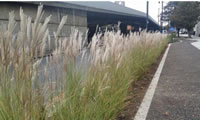Talgarth Road Green Corridor Wins Major Award
Tall grass protects cyclists and pedestrians from pollution and drains surface water
An innovative green corridor on Talgarth Road has won a Best Place Management Award for HammersmithLondon, our local Business Improvement District, or BID.
HammersmithLondon won the awards for its work transforming a neglected part of the town centre into a vibrant and ecologically sustainable new pathway and cycle lane.

The BID Awards are run by British BIDs and are held to acknowledge the efforts made by business improvement districts to enhance their areas.
HammersmithLondon won the award after receiving 53% of the public vote for helping to create the new green corridor.
As we reported last month, the corridor, located in the shadows of the Hammersmith Flyover, the corridor serves as an attractive and biodiverse route that helps to boost air quality, reduces surface water run-off and acts as pleasant green space in Hammersmith for visitors and wildlife to enjoy.
A multi-partnership project between HammersmithLondon, Hammersmith & Fulham Council, Transport for London and the Greater London Authority, the corridor was officially completed in May 2016 after three months of construction work.
Talgarth Road has gone from an uninspiring grey area into a flourishing green corridor by with a new cycle lane and planting, new trees and SUDs drainage to help attenuate rain water using SUDS reduce carbon and attract new wildlife.
Patricia Bench, BID Director, said: "We’re absolutely thrilled to win this Best Place Management award, especially as it was decided by a public vote, so thank you to everyone that voted for us. This has been a great project to work on and we’ll be glad to share this success with our partners.
"The Talgarth Road Green Corridor has drastically improved an underused and quite grey part of the town centre and although it’s only a few months old, we’re starting to see some very positive results."
The project, originally envisioned as a new safer cycling scheme, runs between Butterwick and Shortlands to the north of the Hammersmith Flyover and includes areas of tall grass called miscanthus.
Within two years the grass will grow to a height of around two metres, creating a natural barrier between people and the road.
Air pollution monitors installed on the site will track the effects of the grass in stopping vehicle fumes from reaching cyclists and pedestrians.
Surface water from this stretch of road drains into the roadside planting, reducing the strain on the sewer system and helping prevent floods.
The scheme also trials innovative new materials such as the 'flexipave' cycle path; a hard wearing recycled rubber which is water permeable to also help drainage.
It also includes the latest LED Lighting, CCTV cameras and Smart City Sensors to measure air quality, control street lighting and will also soon be installed with a sensor for counting traffic volumes.
The council has also pioneered other sustainable drainage schemes across the borough, in Mendora Road, Fulham, Melina Road, Shepherds Bush, the award-winning Bridget Joyce Square in Australia Road, White City and the newest scheme in Fulham's Stevenage Road.
November 25, 2016
Related links
|
